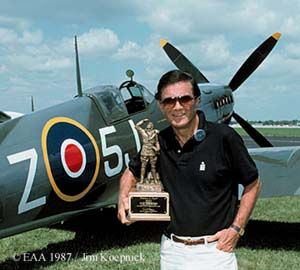 Cliff Robertson was born in La Jolla,Calif,. and saw his first airplane at age five. By age 13, he was a dedicated hangarrat and his reward for washing and waxing was a little unofficial stick time. Years later,in the suburbs of London, the urge to fly surfaced again and hasn’t gone away since.
Cliff Robertson was born in La Jolla,Calif,. and saw his first airplane at age five. By age 13, he was a dedicated hangarrat and his reward for washing and waxing was a little unofficial stick time. Years later,in the suburbs of London, the urge to fly surfaced again and hasn’t gone away since.
Cliff is far more than a casual flier. He holds single-engine land and sea,multiengine, commercial, instrument, balloon and glider ratings. He keeps a P58 Baron nearhis home on Long Island, N.Y., a Stampe SV4 aerobatic biplane at Santa Paula, Calif., forfun around L.A., and a Grob Astir glider in the Sierras.
Cliff just finished his 58th feature film playing a variety of roles. He wonthe Academy Award for best actor in “Charly.” He was handpicked by PresidentKennedy to play the lead in “P. T. 109.” He blended acting and flying in”The Pilot,” “633 Squadron,” and added directing in “J. W.Coop.” He “reached out and touched us” for several years in ads forAT&T. He created and played a Shane parody called “Shame” on the”Batman” TV series. Fans of “Outer Limits” know that Cliff starred inthe very first episode, “The Galaxy Being.” “Gidget” fans know thatCliff was the original “Big Kahuna.” One of his roles in Hollywood was exposingthe systematic corruption of studios, producers and agents known as the “BegelmanScandal.”
He has used his celebrity to promote aviation, too. He was the first Honorary Presidentof the EAA and won the Freedomof Flight Award in 1987. He has spoken to and won awards from almost every pilot andaviation industry group, and set up the Cliff Robertson Work Programat EAA to give kids a chance to earn flight lessons by doing some hangar ratting of theirown.
Did you always want to be an actor?
I started as a journalist. I never intended to be an actor, but you can see whathappens when you fall in with bad companions. I went to Antioch College in Ohio and wrotefor the Springfield Daily News. They accused me of being able to write, but it wassuggested that I consider writing for the theater instead of a deadline. I ventured intoNew York exploring the possibility of writing for the theater, although I didn’t know adamn thing about it. I took a job with some regional companies to learn the craft. I drovea truck. I learned how to build flats. And I acted because everybody in the company had toact.
I was a cocky WASP from La Jolla and I was in an environment that was hardly La Jolla.The actors took themselves and the theater very seriously and I didn’t. I didn’t care muchat all or try very hard, and now I look back on my attitude in that period as shameful.Nevertheless, I was lucky to get good reviews and got some jobs in off-Broadway andfinally Broadway. Then I was accepted in the Actors Studio so I got my training and beganto learn how little I knew.
Eventually I did my first film in Hollywood. I came out West, said the lines, picked upthe check and went home. And I still do it that way. I never really lived in Lala Land,never embraced the lifestyle. I’ve just finished my 58th feature film and I’vebeen a lot luckier in the business than I deserved. I have a lot of friends who live here[in Southern California] and I have high regard for them, but I’ve never felt reallycomfortable in the Hollywood scene. I’d rather be in the country by myself, or with abunch of pilots.
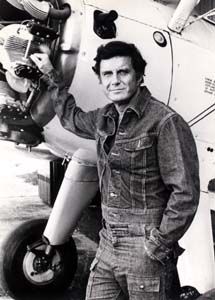 When did you get interested in flying?
When did you get interested in flying?
When I was 13 years old, I would ride my bicycle 13 miles from La Jolla to what wasthen called Speer Airport, which was not far from where San Diego’s Lindbergh field isnow. I was a hangar rat. I’d go there six days a week in the summer just to work – nevergot paid – to get the opportunity to be around airplanes and pilots. I’d wash planes andengine parts and never got paid a dime. I was short for my age, and every third or fourthday someone would say “Go get your cushion” and I’d get about 15 minutes in alittle red Taylor Cub. I thought I was the luckiest kid on the block. That was my activeintroduction to aviation.
I use the word “active” because my first exposure to aviation was at aboutage five when a little yellow airplane was circling over my house. I was watching it withmy uncle and another man and I was just fascinated with it. I remember one of the mensaying, “Damned fool … you’ll never get me up in one of those little planes.”We got into the car and the car wouldn’t start and something clicked in my head that thelittle airplane was purring along safely back to its nest and we were stuck with a carthat wouldn’t start. So I got the realization early that aviation could be safer and moredependable than cars … depending on the airplane and the car, I guess.
Did you solo and get a license as a teenager?
I didn’t get a license. I wasn’t old enough. Did I solo? [smiles] Well, youhave to be a certain age, don’t you? Years later, I was doing a movie in England and Idecided it was time to get back to flying. I joined the Fairoaks Flying Club in Chobham,Surrey and took lessons from Wing Commander Arthur, who had to have been 70 years old. Hewas a raspy old curmudgeon that had flown in WWII and a little bit in WWI. He would bringhis picnic basket with a sandwich in it before the lesson. Someone told me that when hegot older they wouldn’t let him fly anymore but he said “Well, you can’t keep me fromcoming out out to the airport,” which he did, and finally they broke down and let himgo flying again. So that’s where I soloed, at Chobham.
What airplane did you solo in?
In the Tiger Moth. I wanted to – I insisted – in training in the Tiger. I figuredthat if I could land a biplane in a crosswind, particularly a low-horsepower biplane, Icould land anything. They allowed me to do it, but it was a little unusual. They had Cubsand Tri-Pacers and the standard trainers.
Then I joined the Royal Aero Club and the Tiger Club in Redhill, Surrey. I bought myfirst Tiger Moth from there and flew it across the Channel so I’d have something to keepme company when I was in Normandy doing a film called “Up From the Beach.” Everyweekend I’d take it out and fly over Mont St. Michel and just had a blast. I shipped itback and realized I needed parts, and I found out about another Tiger Moth at Clark in thePhilippines. So I bought that one, very cheap, for parts for the first one. Well, when itarrived it turned out to be in better shape than the first one. Then I bought a third onefrom England for parts for the other two and it was in good shape, too. So that’s how youwind up with three Tiger Moths.
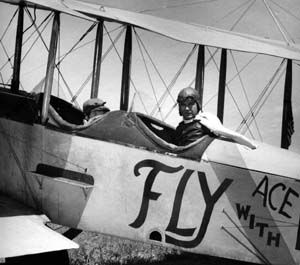 You fought the battle for the certification of theTiger Moth. What was that like?
You fought the battle for the certification of theTiger Moth. What was that like?
Unending bureaucracy. A Kafka nightmare. It took six years of flying back to the FAAand finally we were able to get the experimental designation removed. I didn’t expect itto take six years. It became a kind of crusade for me. I was whining one time to a fellowat the FAA and he took me into a room filled floor to ceiling with books and he said”That’s why you’re having so much trouble. It’s all law books.” That’s howlawyers make money, and they write the rules.
In 1986 you flew Gustave Whitehead’s design which is supposed to have flown beforethe Wright Brothers. How did you get involved in that issue?
They found me. They asked if I’d come up to Bridgeport, Connecticut where they had madea model based on his plans and documentation. They didn’t have the engine for it, but theyhad the airplane. They had evidence that he had actually flown in 1901. He was a Germanimmigrant, very intelligent, native genius. They talked to people that had lived thereback then, and they found a woman who had been a young girl. Her family had a farm nearbyand Whitehead was experimenting there. So they asked her if she had seen the airplane andshe said “Oh yeah, I used to see the airplane. I’d see it up at this end of the fieldand then later on I’d see it down at that end of the field.” Then they asked her”Well, did you see it fly?” And she said “No, it didn’t fly.” And theysaid “How did it get to the other end of the field?” And she said “Well, itwent up in the air and flew along for a while and then came back down, but it didn’t goanywhere.” She was thinking in terms of an airline.
So then I was interested. I got on it and they put it on a flatbed behind a sports carand a tether line on it. The plan was for me to stand on it – more on it than in it -and they’d tow it along and when it got enough speed I would try to get it in the air. Sowe went out early one morning, with a lot of press, and I’m just standing on it. We did arun and nothing happened. And we did a second run and nothing happened. Then the wind cameup a little and we did another run and, sure enough, I got her up and flying. Then we wentback and did a second one. So his aircraft was capable of flying.
Do you get a chance to fly when you’re working in L.A.?
I have a hangar in Santa Paula which I built about 25 years ago. I housed theTiger Moths there for about 20 years. Now I keep the Stampe SV 4, the French aerobaticbiplane there. I have a Baron, a P58 straight, in East Hampton, Long Island, just 10minutes from where I live. I fly the Baron across the country when I’m not in a hurry. Iusually take a couple of days to make the trip. I’ve done it in one day, but coming westit takes about 14 hours, and that’s a long day.
I got into soaring about a dozen years ago and I’ve become really addicted to that. Ikeep a Grob at Minden [Nevada] at High Country Soaring. Tom andBill Stowers are great people and they get soaring enthusiasts from all over the worldthat come there for the Sierra waves. I was able to get my diamond altitude, over 26,000feet. I got lucky and set a Nevada state distance record in my Grob Astir. I went about240 miles from Tonopah to Parowan. Six hours and twenty minutes is a long time to sitthere nursing your kidneys.
Were you trying to set a record or did you just get some lift that was too good togive up?
We set out to do it. A friend of mine had the idea and he brought along the barographand all the technical things we needed to qualify. The poor guy is 6-foot-5, so hisknees were under his chin the whole time.
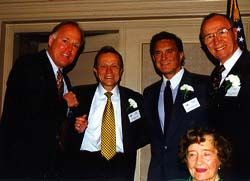 Standing L to R: Jim Coyne, President, NATA; Tom Poberezny, President, EAA; Cliff; and the late Admiral Don Engen. Seated: Ms. Cliff Henderson |
I lost two good friends up there last summer. Don Engen and Bill Ivans. Bill lived inLa Jolla and had flown gliders for many years, and Don had gotten into soaring just afterI did. They were both rather quiet men, so I wrote a poem called “Quiet Men on QuietWings.” Bill’s son Dennis read it at the funeral.
How has Hollywood changed since you exposed the Begelman scandal?
Someone asked me what I’m proudest of and it would be my two daughters, but I’m alsoproud of the fact that we did expose that corruption. My accountant says “No more DonQuixote, Cliff.” I was blackballed for three and a half years and didn’t work at all.The town was for me, the actors, writers, directors, but there were a few scoundrels that- as the FBI put it – their honeymoon was about to end. But somebody had to stand up tothe barracudas and as a result more and more people came out and exposed what had beengoing on. They were afraid. Within two years of what we did, Laurence Olivier, SeanConnery, Michael Caine, Richard Attenborough, and James Garner, among others, startedconfronting corporate corruption and creative bookkeeping. They figured since I was stillalive that maybe it was safe and they’d survive, too. Hollywood is a town that thrives onpointing the finger at corrupt governments and individuals, but they’re very reluctant toturn that finger around and point it at themselves.
I’ve written a sequel to “Charly.” I’m waiting for somebody with deep pocketswho wants a movie that’s not filled with violence and prurient sex, and is still based onan Academy Award-winning performance, and I can do it for a modest budget. Hollywooddoesn’t operate that way. A guy said “What’s your budget?” and I said”About seven million,” and he said “I can’t steal a million out of sevenmillion … now if it’s 27 million, I can take a little off the top for myself.”Well, I’m an old Scot and I’m pretty careful about other people’s money, as well as myown, so the sequel is going to have to wait for the right deal to come along.
I’m also proud that after all these movies, I’ve never been obligated to salute, snapheels or live in Hollywood. I’m the last of the independents in that sense.
Have you done any stunt flying for the movies?
In “J. W. Coop” I flew the biplane. It wasn’t stunt flying particularly. Itwas a film that I wrote, directed and starred in about a rodeo cowboy. It was really aboutman’s confrontation with change, but I flew the Tiger Moth in that. In a picture Idirected and starred in called “The Pilot” about an alcoholic airline pilot, Iflew a DC-8. Those are the only two that come to mind.
Who are some of the stunt pilots you worked with?
I don’t think anybody can touch my buddy Sean Tucker, but there are so many greatpilots. I knew Art Scholl very well. Frank Talman was a friend of mine. They’re both gonenow. They held Frank’s funeral in Orange County, about an hour south of L.A. He risked hisbutt for actors and directors – of course, he was paid – but he risked his butt for30 years so that they could get the shots they needed. Over 700 peopleshowed up for the funeral, some from the east coast, and there wasn’t one actor – star -in the bunch. No directors that we know of. Certainly no producers. But the stunt men werethere. It was sad that they couldn’t take an hour’s drive to pay homage to the guy.
JFK picked you to play him in “P. T. 109.” Did you get to meet him?
Oh, yeah. He was great. I was doing a movie in New York with Jane Fonda called”Sunday in New York” and the White House called and said the President wouldlike me to come down to Washington. We corresponded after that, and he gave me some gifts,but it wasn’t too long after that he was killed.
Did you meet John, Jr.?
I did. I talked to him on the phone, then we met at Oshkosh in ’98. I never flew withhim. He was a good guy. Often there’s a cocoon around celebrity and people are afraid totell the emperor he has no clothes. John was a 38-year-old man using the judgment of ateenager. It was tragic. It didn’t have to happen. All he had to do was call hisinstructor or a charter pilot and take them along and buy them a ticket home. He couldcertainly afford it. He could have gone the next morning, stopped along the way. So manyouts he didn’t take. Long Island is my neighborhood. I won’t fly my Baron over there inbad weather … and I’m instrument-rated and I’m flying a twin.
If I were a flight instructor and I had a student who was famous, I hope I’d be able tosay “Listen, I don’t care what your name is or how much money you’ve got. All I careis that on my watch you’re not going to do something dumb. You’re not going to killyourself and you sure as hell aren’t going to kill someone else.” I hate to say toomuch about him since he’s dead, but if there’s a plus side to it, it would be that itdraws attention to the carelessness and may prevent somebody else from making thatmistake.
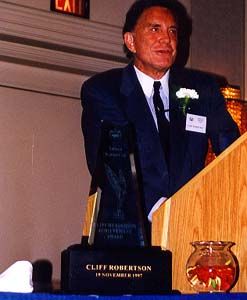 What’s the tightest spot you’ve had as PIC?
What’s the tightest spot you’ve had as PIC?
Flying gliders is not only a great recreation, it’s also very good training becausewhen you don’t have an engine, you’re committed. Like all glider pilots with anyexperience I’ve had a few land-outs, where you don’t get back to the airport, but I alwaysmanaged to find a road or a field that worked just fine. Back at Speer, when I was 14years old, in one week I was in two forced landings. Not with me flying, but flying withguys whose airplane I had washed. One was a Great Lakes trainer up at Camp Kearney, whichis now MCAS Miramar. We were doing touch and goes, he blew a rod and it went right throughthe cowling, and he sideslipped and brought it down. He was white as a ghost. I was14 and I thought it was pretty exciting. Three days later I was up in a KinnerSportster at 15,000 feet, freezing my butt off, and oil pressure dropped and wedeadsticked back in. I went home proud as a peacock to have two forced landings in oneweek.
I was shooting a film out in the boonies and they wanted me to fly the Tiger Moth outof a hayfield in a canyon. There was a lot of wind up there and the Tiger Moth is alow-horsepower airplane. So I said I would only do it early in the morning in calm winds,and I wanted two cameras on the wings and one on the front cockpit, and I wanted themmounted on the airplane two days ahead of time. Then I gave them the key to the hanger inSanta Paula.
You can guess what happened. I got there at 5 a.m. on the day of the shoot and nothingwas ready. I flew the airplane over to the hayfield and the winds came up and I refused todo the shot. It’s my own fault but I let them talk me into it. I got all the shots,pulling little strings to trigger the cameras from the cockpit. Now it’s time to land. Idid a low pass and realized the wind was really blowing. I had seen an area of grass whenI checked out the area before the flight. After my low pass I got a big downdraft, likethe fist of God, and I hit the power. The Tiger Moth is a gravity feed fuel system andwhen the airplane went down I had fuel starvation. I instinctively aimed for that littlepatch of grass, but there were a couple of crewmembers practicing golf over there. So Iaimed the other way, and I’m coming down fast, and I saw a horse. And I figured wherethere’s a horse there’s liable to be grass, and I did a pretty good job of planting thewheels at the edge of the grass. But when the undercarriage sheared off, the airplane wentupside down and I had to scramble out. Bumped my nose but that’s about all.
But you got the shot?
Classic Hollywood. The director was hysterical. I’m a director, too, so I said”This is a great break for you. The airplane is upside down. Get a few guys to throwsome dirt in the air, spin the one wheel that was left on the airplane, and roll yourcameras. We’ll dissolve into the dust and pull back and see a real airplane that’s prettywell bruised.” So I went to the doctor to get some stitches figuring that I hadbroken my airplane and almost broken my ass, but at least we’d get a good shot out of it.But they didn’t. The director said everybody was nervous and sent them home.
What’s keeping you busy in aviation now?
I love flying and I love the flying fraternity. I’m very active in the EAA … I wasthe first Honorary President and I’m on the President’s Council of the EAA. I’ve flown alot of Young Eagles, and we’re well on our way to the goal of flying a million kids by2003. Every yearwe choose four kids who apply for the Cliff Robertson WorkProgram. These are boys and girls that have shown great passion and energy for flyingand they get free lessons in return for doing what I did – cleaning out dirty hangars andwashing airplanes. After 10 weeks they solo, and they’ve all gone on to good things. Mostof them have stayed in aviation.


































